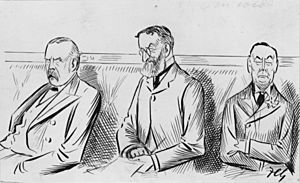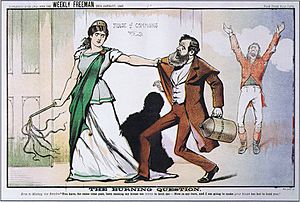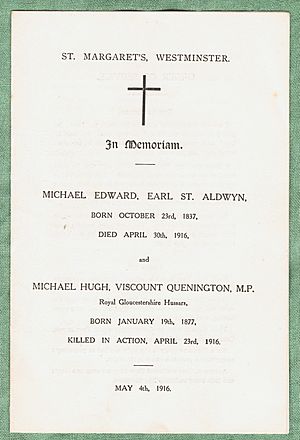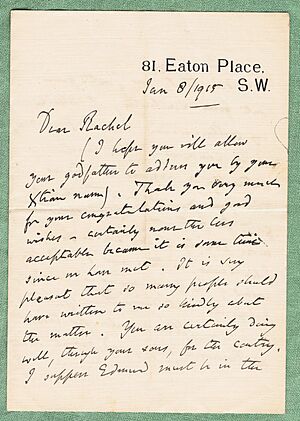Michael Hicks Beach, 1st Earl St Aldwyn facts for kids
Quick facts for kids
The Earl St Aldwyn
|
|
|---|---|
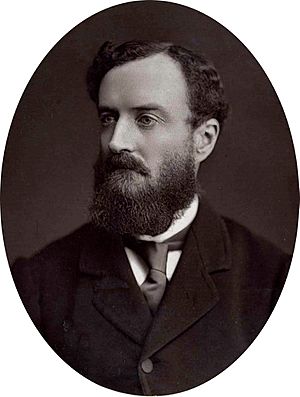 |
|
| Chancellor of the Exchequer | |
| In office 24 June 1885 – 28 January 1886 |
|
| Monarch | Victoria |
| Prime Minister | The Marquess of Salisbury |
| Preceded by | Hugh Childers |
| Succeeded by | Sir William Harcourt |
| In office 29 June 1895 – 11 August 1902 |
|
| Monarch | |
| Prime Minister | The Marquess of Salisbury |
| Preceded by | Sir William Harcourt |
| Succeeded by | Charles Ritchie |
| President of the Board of Trade | |
| In office 21 February 1888 – 11 August 1892 |
|
| Monarch | Victoria |
| Prime Minister | The Marquess of Salisbury |
| Preceded by | The Lord Stanley of Preston |
| Succeeded by | A. J. Mundella |
| Personal details | |
| Born | 23 October 1837 London |
| Died | 30 April 1916 (aged 78) Coln St Aldwyn, Gloucestershire |
| Nationality | British |
| Political party | Conservative |
| Spouses |
|
| Children | 4, including Michael |
| Alma mater | Christ Church, Oxford |
Michael Edward Hicks Beach (born October 23, 1837 – died April 30, 1916) was an important British politician. He was a member of the Conservative Party. People sometimes called him "Black Michael."
He held several big jobs in the government. He was the Chancellor of the Exchequer (like a country's finance minister) twice. He also led the Conservative Party in the House of Commons. Because he served for so long, he was known as the "Father of the House."
Contents
Early Life and Education
Michael Hicks Beach was born in London. His father was Sir Michael Hicks Beach.
Michael went to two famous schools: Eton College and Christ Church, Oxford university. He studied law and history there. In 1854, when he was 17, he became the ninth Baronet after his father.
Political Career: First Steps (1864–1888)
In 1864, Michael Hicks Beach became a Member of Parliament. He represented East Gloucestershire for the Conservative Party.
He took on several important roles. In 1868, he worked for the Poor Law Board and the Home Affairs department. In 1874, he became the Chief Secretary for Ireland. This was a very important job, and he joined the Cabinet in 1877.
From 1878 to 1880, he was the Secretary of State for the Colonies. This meant he was in charge of Britain's colonies around the world. In 1885, he became the Chancellor of the Exchequer. This role is like the country's main money manager. He also became the Leader of the House of Commons. This meant he was the main spokesperson for his party in Parliament. He had to step down in 1887 due to eye problems.
Political Career: Later Years (1888–1902)
From 1888 to 1892, Hicks Beach returned to government. He became the President of the Board of Trade. This role involved looking after trade and business.
In 1895, he became the Chancellor of the Exchequer again. He had to manage the country's money during the Second Boer War in South Africa. He raised taxes, including the income tax. He also added taxes on sugar and coal. In 1902, he brought back a tax on corn and flour.
He sold some of his family's land in Wiltshire to the War Office in 1898. After the Prime Minister, Lord Salisbury, retired in 1902, Hicks Beach also left the government. After he resigned, he and his family visited Egypt.
Other Important Roles
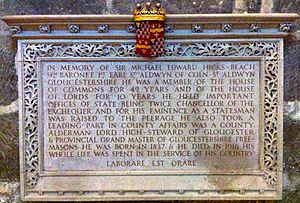
Michael Hicks Beach took on other important jobs. He led a special group called the Royal Commission on Ritualistic Practices in the Church. He also helped settle disagreements as an arbitrator.
He was a strong supporter of free trade. In 1906, he was given a special title and became Viscount St Aldwyn. In 1915, he received even higher honors. He was made Viscount Quenington and Earl St Aldwyn.
Family Life
Lord St Aldwyn was married twice. His first wife was Caroline Susan Elwes. They married in 1864. She passed away in 1865.
He then married Lady Lucy Catherine Fortescue in 1874. They had one son, Viscount Quenington, who also became a politician. They also had three daughters.
His second daughter, Susan Hicks Beach, was a model for the image of Britannia. This image appeared on the back of the Edward VII silver florin coins from 1902 to 1910.
Lord St Aldwyn died in April 1916, at 78 years old. This was only a week after his son was killed in the First World War. His grandson, Michael, took over his titles.
His wife, Lucy, helped create a Rural Nursing Association in the 1880s. This organization helped provide nursing care in the countryside. The coastal town of Beachport in Australia was named after Lord St Aldwyn in 1878.


